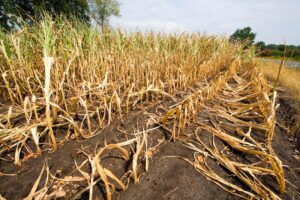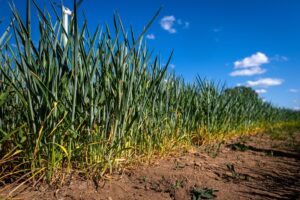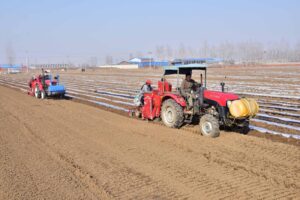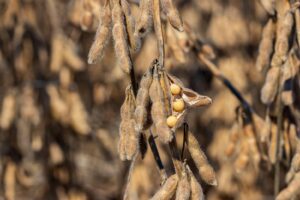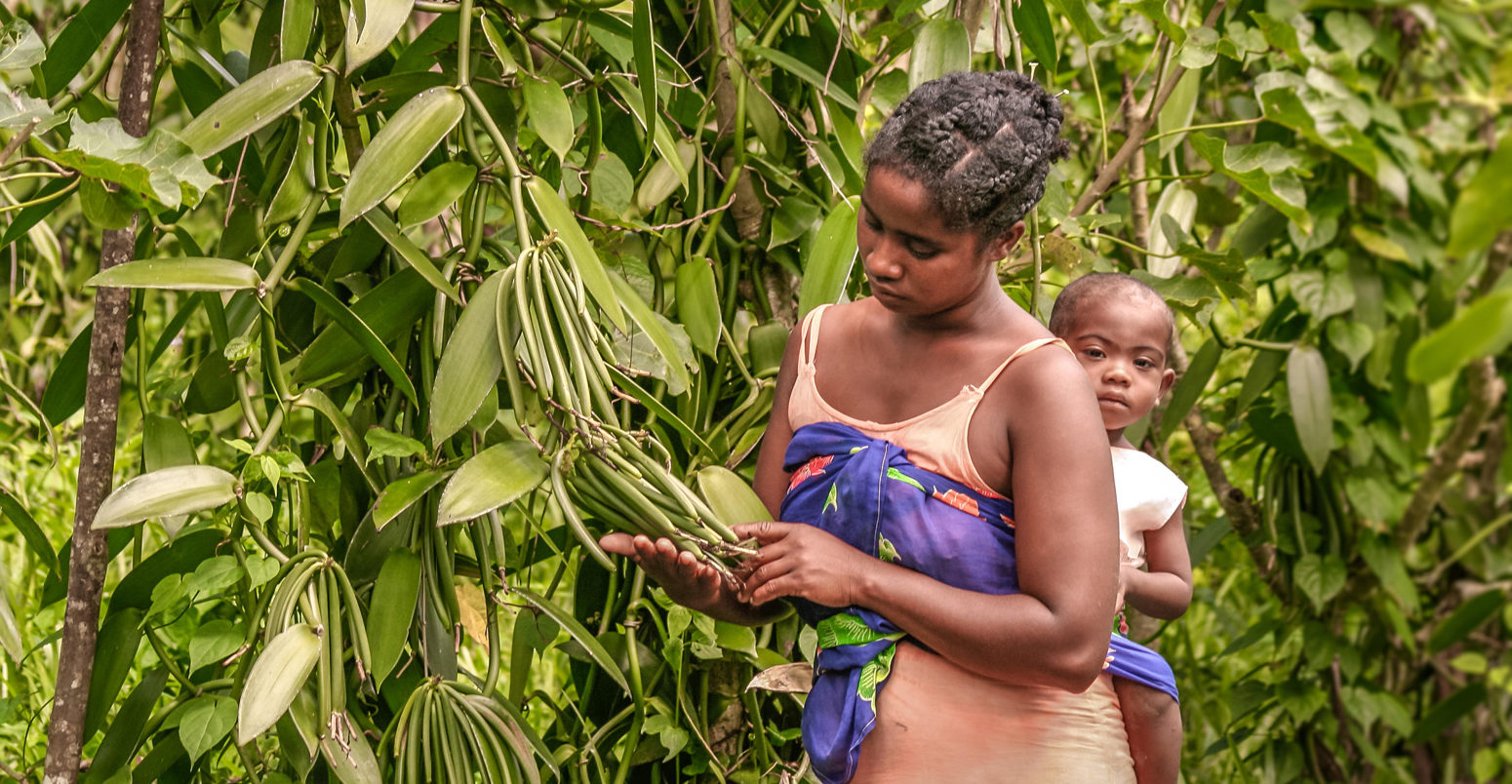
Planting trees in tropical cropland could create ‘win-win’ for nature and farming
Freya Graham
08.22.22Freya Graham
22.08.2022 | 8:00amPlanting trees across tropical farmland can help to restore biodiversity without sacrificing crop yields, a new study finds.
The research examines the impacts of “agroforestry” – a practice whereby farmers grow trees and agricultural crops in the same space – on vanilla production in Madagascar.
It finds that establishing vanilla agroforests across fallow land – arable land that has been set aside to recover for a period of time – increases species richness by 12%, when compared to fallow land without agroforests.
The results show that increasing levels of species richness were not associated with a decline in vanilla yields, suggesting agroforestry could offer a “win-win” solution for farmers and biodiversity, according to the study authors.
However, the research also finds that establishing agroforests in existing forests is associated with a 23% decline in species richness – highlighting that the benefits of agroforestry hinge on the type of land it uses.
Prioritising agroforestry on open land as opposed to converting old growth forests is a “no brainer” for jointly addressing both climate change and biodiversity loss, a scientist not involved with the study tells Carbon Brief.
‘Win-win opportunities’
The African island nation of Madagascar is the world’s largest vanilla producer. The commodity provides a major source of income for smallholder Malagasy farmers. An estimated 87% of Malagasy farmers live below the national poverty line.
The island is also a hotspot for unique biodiversity. Madagascar is home to a large number of “endemic” species – those that are not found anywhere else on Earth. Some 98% of amphibians and 74% of reptiles on the island are endemic.
Agricultural practices threaten forests and biodiversity on the island. “Slash-and-burn” farming – cutting down and burning vegetation to clear land for new crops – is a major driver of deforestation and land degradation in Madagascar. The country has lost 44% of its old-growth forest since 1953.
The study, published in the journal Nature Communications, examines how agroforestry – a practice where trees and crops are grown alongside each other – could impact local levels of biodiversity and crop yields for vanilla crops in Madagascar.
Agroforestry has previously been touted as a solution for declining levels of biodiversity on agricultural land, as well as a potential land-based climate solution. This is because including more trees in cropland can increase levels of carbon storage.
The findings show that agroforests can restore biodiversity on land – provided it is carried out across fallow land rather than intact forest, says study co-lead author Dr Annemarie Wurz, an ecologist at the University of Marburg in Germany. She tells Carbon Brief:
“[Vanilla] yield does not differ between agroforests that were established on fallow land compared to agroforests that were established in the forest. This means that farmers do not have to clear forest to achieve high yields, but can cultivate vanilla on fallow land and thus also increase the biodiversity value of this land.”
Tracking wildlife
The researchers tracked seven wildlife groups to measure biodiversity: trees, herbaceous plants, birds, amphibians, reptiles, butterflies and ants.
For each group, they recorded the “species richness” – the number of species in a given area – across forest and fallow-derived vanilla agroforests, fallow land, old-growth forests and “forest fragments” – small patches of forest that are separated from larger forested areas by roads, agriculture and other human developments.
The plot below shows the overall species richness across different land-use types.
The boxplot on the left shows species richness in the five types of land that the researchers analysed – old-growth forest in dark green, forest fragment in light green, forest-derived vanilla agroforest in blue, fallow land in yellow and fallow-derived vanilla agroforest in brown.
The scatter plot on the right shows the relationship between vanilla yield and biodiversity. The blue dots represent forest-derived agroforests and the brown dots represent fallow-derived agroforests. The dots towards the top indicate agroforestry plots with the highest biodiversity levels and dots to the right show those with the highest vanilla yields.
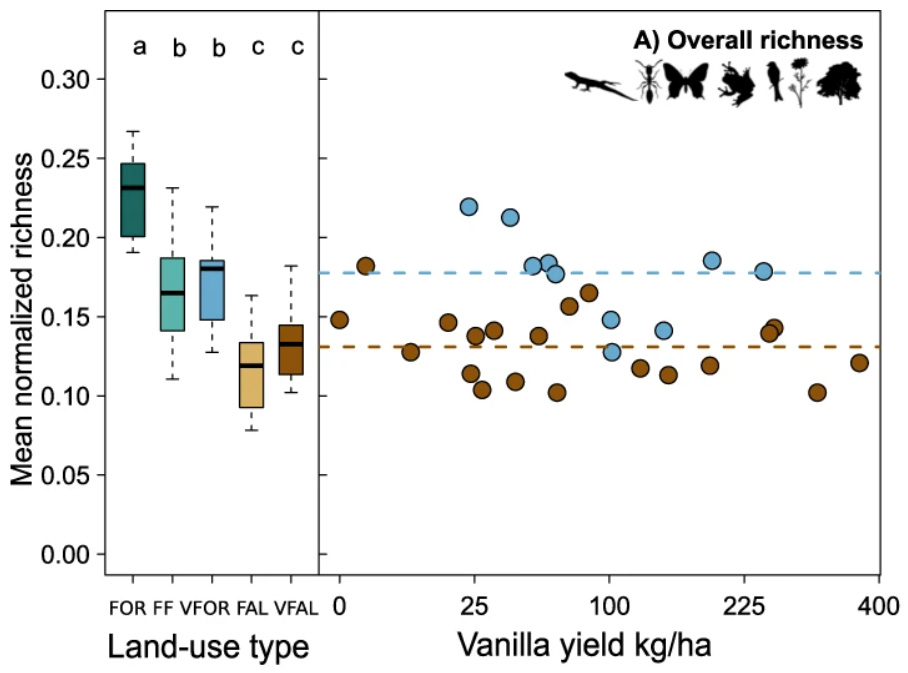
The chart shows that high yield is not associated with decreased biodiversity, marked by the dashed blue and brown lines.
This finding illustrates that farmers can produce high yield crops without compromising wildlife, Wurz explains:
“Plant and animal diversity can be increased by measures that do not conflict with higher vanilla harvests. Such measures include increasing or maintaining high tree cover in the agroforests and maintaining high forest cover in the landscape.”
Endemic species
The study also finds that vanilla agroforests on fallow land particularly benefit Madagascar’s endemic species. Wurz explains:
“We integrated endemic species in our research because they are emblematic of Malagasy biodiversity and because endemic species have been shown to be more sensitive to land-use change thus they are a good proxy for conservation value.”
Agroforests in fallow land had overall 38% more endemic species, when compared to fallow land without agroforests, according to the findings.
However, the study also identified tradeoffs between vanilla yields and some endemic species, including reptiles and butterflies.
The chart below is the same format as the earlier figure, but shows the results specifically for the relationship between the species richness of endemic butterflies and vanilla yield.
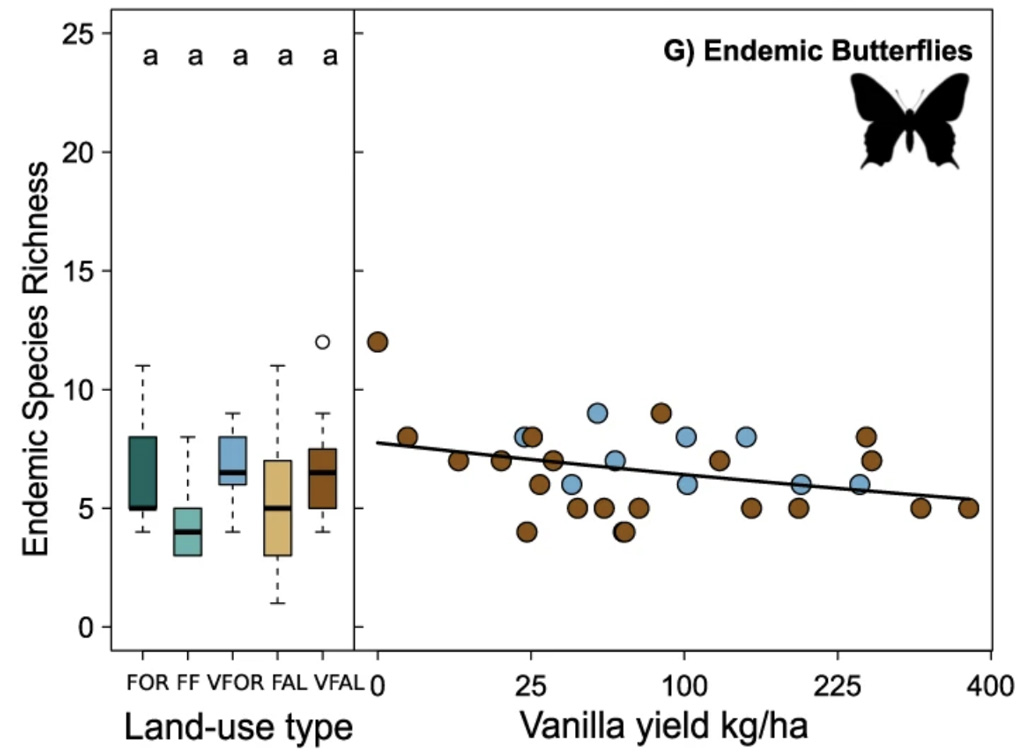
This chart shows that the richness of endemic butterfly species decreases as vanilla yield increases. While Wurz says more research needed to understand this impact, she explains one possible cause:
“Butterflies are sensitive to habitat changes due to their complex holometabolous life cycle [involving a complete metamorphosis], feeding and host plant specialisation, thermoregulation, and symbiotic associations. Thus, the intensification of management could impact their survival and presence on the vanilla plots”
Findings for farmers
Overall, the research suggests that incentives should be introduced to encourage farmers to convert fallow land to agroforests, says Wurz.
Smallholder farmers are unlikely to be able to transition to agroforestry without financial assistance, she says:
“Many households in the region – particularly the very poor ones with no access to paddy rice cultivation – rely on land for shifting hill rice cultivation. They struggle to establish productive fallow-derived vanilla agroforests because they need the labour they have for their shifting hill rice cultivation. Thus, contractual arrangements which offer farmers food aid, credits, income stability and premium prices – particularly for the first three years of vanilla cultivation – can help to promote fallow-derived vanilla agroforestry in addition to the indispensable subsistence agriculture.”
These incentives, Wurz adds, should consider “land-use history” – whether the land has previously been farmed or left as intact forest.
This is something which has been overlooked in the past in research and planning, the authors say in their research paper.
Dr Nathalie Pettorelli, a senior research fellow at the Zoological Society of London who was not involved in the research, agrees that considering land-use history is a new development in agroforestry research, adding:
“As such, these conclusions call for prioritising agroforestry on suitable open land as opposed to converting old growth forests into forest-derived agroforests. Doing so would help jointly address the current biodiversity and climate change crises, while contributing to food security. A no brainer.”
Dr Martin Sullivan, a statistical ecologist at Manchester Metropolitan University who was also not involved in the study, adds that it is encouraging that “actions to increase yield within vanilla agroforestry systems can happen without loss of biodiversity”.
However, Sullivan also highlights the potential knock-on consequences of converting fallow land to vanilla agroforests, telling Carbon Brief:
“Fallows are repeatedly used [in the region], to the extent that secondary forest establishment is prevented. If these fallows are converted to vanilla, will that increase pressure on remaining forest for other types of agriculture, leading to negative consequences for biodiversity?”
Wurz, A. et al. (2022) Win-win opportunities combining high yields with multi-taxa biodiversity in tropical agroforestry, Nature Communications, doi:s41467-022-30866-8
-
Planting trees across tropical farmland can help to restore biodiversity without sacrificing crop yields, a new study finds.


